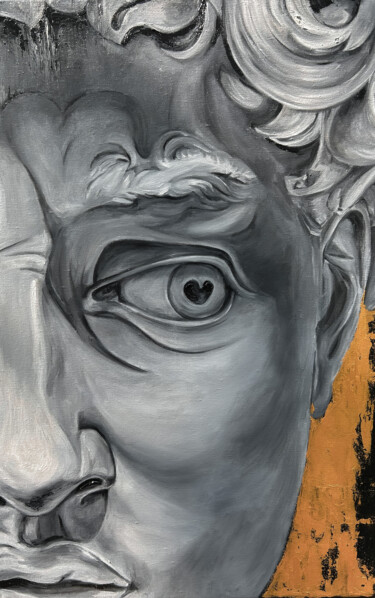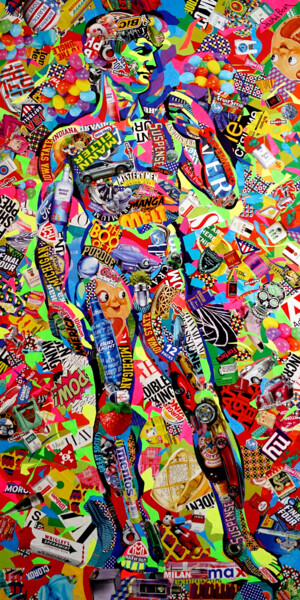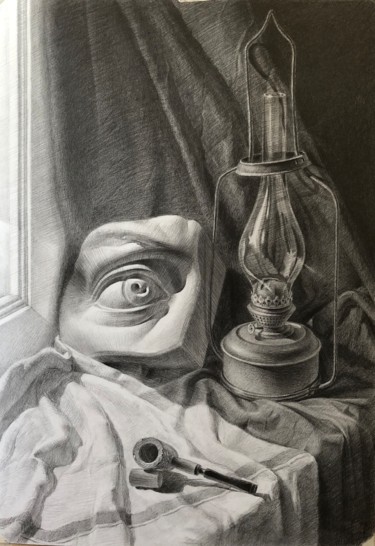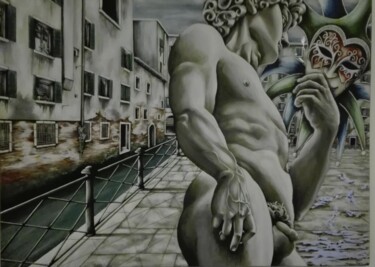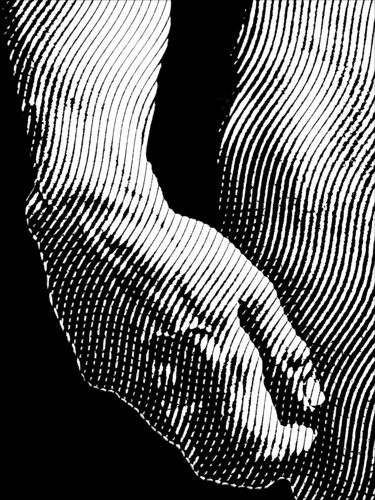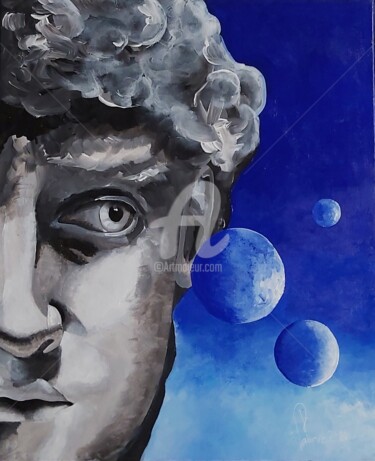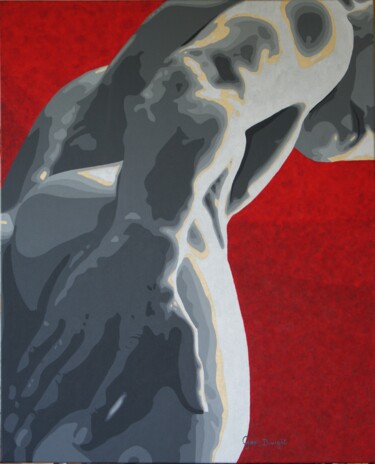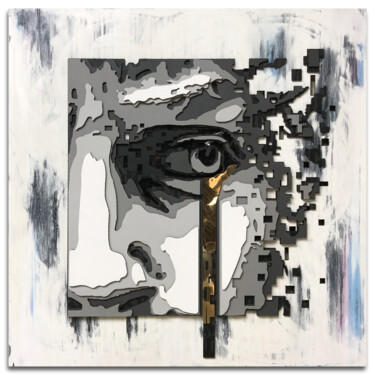 DAVID MICHELANGELO HUGO BOSS (2021)Printmaking by Tony Rubino.
DAVID MICHELANGELO HUGO BOSS (2021)Printmaking by Tony Rubino.
Against the censorship of art
My top ten has selected the best nude, crude, sensual, sometimes erotic and, as a result, extremely "scandalous," "demonic" and sometimes "dangerous" masterpieces for the eyes of those viewers most susceptible to the externalization of the sinuosities of the human body, characters that I dare to deem worthy of a leap back in time to the era of the Braghettone, that is, of Daniele da Volterra (1509-1566), an artist who earned precisely the aforementioned nickname in the late 16th century, a sort of Mr. Underpants when literally translated from Italian, in that he was called upon, following the Council of Trent, to cover the nudity of Michelangelo's Last Judgment in the Sistine Chapel by providing for it to be concealed behind breeches and dresses. To the "Braghettone" gentlemen and ladies, I would like to point out the content, which nowadays is being disseminated on the web and social media, channels of communication, into which every minute images and videos of maidens whose nipples are glimpsed, or of figures captured while engaging in the most explicit of twerking, or caught in micro-thongs in rather inviting and winking poses. At this point, do the David's member, the Olympia's breasts, the buttocks of Courbet's bathers, mute, statuesque, and above all designed only to be observed, contemplated, and not to stimulate the desire to initiate long private chats, seem so damaging to our drifting society? In addition, you do not think about the long work behind the conception and realization of the aforementioned masterpieces, as well as the historical artistic background that they represent, all the more so precisely when compared with the "ignorant" butt of an anonymous ordinary person displayed on Instagram. After this outburst, I will leave you with the masterpieces, hoping that the story behind each work will make you understand how beyond a genital organ, a breast and a buttocks, there is an inestimable intellectual value, which posterity deserves to know, as there is no such thing as obscenity if what is put on display is explained, contextualized, narrated, analyzed and well told in its intent of creation. Arguably, it has been the superficiality of our age that has turned masterpieces of art into commercial and mere scraps of flesh, exhibited to arouse who knows what erotic thought, or, more often than not, to become empty testimonials used for the purpose of inviting mere pecuniary expenditure.
 Édouard Manet, Luncheon on the grass, 1862-1863. Oil on canvas, 208×264 cm. Paris: Musée d'Orsay.
Édouard Manet, Luncheon on the grass, 1862-1863. Oil on canvas, 208×264 cm. Paris: Musée d'Orsay.
Top 10
10. Édouard Manet, Luncheon on the grass, 1862-1863
Plug your eyes, or you who are still in time, get ready to go confess your sins, because the works ranging from ten onwards represent a descent into the underworld, a place where, as a sort of Virgil, I have chosen Manet as my first companion, a figure who will lead me on the journey through purgatory to eternal damnation, symbolically represented by work number one! All right, sorry, I got a little carried away, I'll get serious again right away to open this ranking with the aforementioned French master's Breakfast on the Grass, a canvas in which a nude woman sits in front of two well-to-do men, wearing dark clothes. The female figure, who directs her gaze directly at the viewer, has assumed a relaxed pose, unaware of the scandal that her presence aroused in the public of the time, who, already bewildered by the pictorial technique used by the artist, immediately guessed that the young lady, who was neither a nymph nor a goddess, must have been a shameless prostitute, a subject banned at the time the painting was made, as the presence of the nude was justifiable only by reference to mythology or allegory. Finally, it is good to make it known how for the realization of such an "affront" Manet took his cue from Titian's Country Concert and, probably, also from some sixteenth-century prints by Marcantonio Raimondi from Raphael's Judgment of Paris, sources of inspiration that were transformed into a deliberately alienating and provocative composition.
 Édouard Manet, Olympia, 1863. Oil on canvas,130.5×190 cm. Paris: Musée d'Orsay.
Édouard Manet, Olympia, 1863. Oil on canvas,130.5×190 cm. Paris: Musée d'Orsay.
9. Édouard Manet, Olympia, 1863
At number nine, probably placed in the circle of the purgatory of the lustful, now perhaps also populated by the voyeurs of the above-mentioned sensual Instagram videos, finds its place another masterpiece depicting a provocative prostitute: Manet's Olympia. The painting, which depicts an unclothed woman lying on a bed, intent on turning, without revealing any emotion, her gaze toward the viewer, proposes yet another unprecedented interpretation of the female nude, which, direct and uncompromising, challenged the bourgeois morality of its era. In addition, to the cold and realistic image of the aforementioned courtesan is also added a further sort of "desecration" of tradition, in that the pose she assumed was mostly that attributed by classical tradition to the figure of Venus, now transformed into a crude association with meretriciousness. What is more, never was the choice of the painting's title more apt, as the name Olympia was by far common among nineteenth-century courtesans, to be associated also with the presence of the black cat, an erotic symbol linked to female sexuality, and the subject of the servant girl, who is intent on handing the model precisely the floral gift from one of her clients. Finally, the unmade bed and the sensual orchid in her hair, as well as the jewelry worn without much refinement, also indicate that the young woman was living an intended "public life."
 Francisco Goya, La maja desnuda, 1790-1800. Oil on canvas, 97×190 cm. Prado Museum, Madrid.
Francisco Goya, La maja desnuda, 1790-1800. Oil on canvas, 97×190 cm. Prado Museum, Madrid.
8. Francisco Goya, La maja desnuda, 1790-1800
From France we come to Spain, always pursuing the intention of engaging, educating and "converting" the "Braghettons" of the world, this time bringing as an example Francisco Goya's Maja desnuda, a canvas depicting a naked young woman who, with an extremely confident manner and without any modesty whatsoever, crosses the viewer's gaze while lying with her head to the left of the work and her hands crossed behind the nape of her neck to highlight the protrusion of her breasts. Now you may ask, and if you haven't, I'll do it for you, why is Maya at position number 8, thus resulting in more scandal than Olympia? The answer lies entirely in the pubis, as the work of the Spanish master shows, in a rather unprecedented way for the time, the hairs of the groin and the linea nigra, or that thin strip of skin, which joins the mount of Venus to the navel. At this point it is necessary to introduce to the context in which the canvas was made, namely 18th-century Spain, a country in which nude paintings were banned as contrary to Christian doctrine, so much so that many were burned by order of the Inquisition. Nonetheless, the commissioner of the work, namely the daredevil Manuel Godoy, a Spanish military man and politician, had a rich collection of such masterpieces, although the Maya Desnuda, perhaps the most explicit of these works, was exhibited only through a superimposition mechanism, whereby the most bigoted were shown only the clothed version of the same subject, depicted by the slightly later painting of the Maja Vestida.
 Amedeo Modigliani, Nu couché , 1917. Oil on canvas, 60 cm × 92 cm. Private collection of Liu Yiqian.
Amedeo Modigliani, Nu couché , 1917. Oil on canvas, 60 cm × 92 cm. Private collection of Liu Yiqian.
7. Amedeo Modigliani, Nu couché , 1917
Imagine yourself in Paris in December 1917, waiting in the cold, perhaps waiting in line, among the multitude of people, who had thronged to attend Modigliani's first solo exhibition, which, held at the Gallery of the art dealer Berthe Weill, was abruptly and prematurely interrupted due to a baleful police raid, the purpose of which was to remove some of the works on display that were considered to be beyond modesty. Lo and behold, among all the paintings that were at the event, and on which the aforementioned accusation fell, you could also discern the depiction of a young woman with dark hair and marked makeup, who, lying languidly on a red bed, turned her blind gaze toward the viewer: I am talking about the Lying Nude of 1917. Just as with the above-mentioned example of the Maja Desnuda, for the Parisian masterpiece, the object of the scandal in question resided, once again, in the presence of hair, which, on this occasion, became visible not only in the pubis, but also in the armpits of the effigy, depicting, probably, the artist's companion Jeanne Hébuterne, or Elvira La Quique, the famous Montparnasse prostitute, singer and model.
 Edvard Munch, Puberty, 1894-95. Oil on canvas, 151.5 cm × 110 cm. National Gallery, Oslo.
Edvard Munch, Puberty, 1894-95. Oil on canvas, 151.5 cm × 110 cm. National Gallery, Oslo.
6. Edvard Munch, Puberty, 1894-95
If a nude figure, whose boyhood is caught in that age that comes close to puberty, were depicted nowadays, the worst accusations would probably erupt against the creator, who would almost certainly be singled out as a perverse lover of underage girls. In reality, Munch's thematic masterpiece, which should by no means be interpreted with the aforementioned malice, confronts the viewer with an obvious physical change, intended to involve all of humanity in that transitional period, which links childhood to adulthood. In fact, Puberty depicts a little girl in the intimacy of her little room, who seems embarrassed in front of our own gaze, capable of grasping the immaturity of her physique, which, concealed in the pubis, but manifested in the small and immature breasts, has yet to develop totally. At the same time, such an immature body casts, thanks to the light coming from the left side of the support, an ominous and threatening shadow, which, placed on the right side of the small room, seems to presage the dramatic future of the effigy, or to externalize her consciously tormented inner state. It would seem, that in the same way that every little girl already knows that she will become a woman, she foresees the power of her future sexuality, capable of making men suffer, who will first derive pleasure from it and then pain and despair.
5. Egon Schiele, Standing Young Female Nude with Orange Colored Stockings, 1914
"No erotic work of art is a piece of filth, when it is artistically relevant, it becomes a piece of filth only through the viewer, if the viewer is a pig." If Schiele's words have unmasked you in your mischievous identity, then, like the good taste buds that you are, I invite you to contemplate in solitude his explicit Standing Young Female Nude with Orange Colored Stockings (1914). Or, if like me, and like the aforementioned master, you recognize its artistic value, noteworthy is its description, ready to summarize how the upright and proud body of a woman, who, not deigning us the slightest bit of her gaze, is presented in orange hold-up stockings, generating the vision of a perhaps lonely, melancholy and forlorn figure, at first glance grotesque and unfavorable. At the same time, such a mode of depiction reflects the master's more typical adoration of the female gender, who frequently eschewed depicting women in passive postures to immortalize them in direct, somewhat immodest, often intertwined and provocative poses, which, as Schiele himself said, still remain "always works of art," that is, masterpieces to be contemplated in their art-historical value, rather than through fanciful red-light associations, which, as Circe did with Ulysses' companions, turn men into swine.
 Gustave Courbet, The Sleep, 1866. Oil on canvas, 135×200 cm. Petit Palais, Paris.
Gustave Courbet, The Sleep, 1866. Oil on canvas, 135×200 cm. Petit Palais, Paris.
4. Gustave Courbet, The Sleep, 1866
Level of mischief arrived at number 4: very high! Perhaps we could already begin to hear the seven trumpets sounded by the angels of Dürer's Apocalypse, as the ravages of planet earth take place, the realm of mischievous and lustful creatures, avid contemplators of erotic works of art such as Courbet's Sleep, an oil on canvas depicting two women, who, laced in a sensual embrace, lie on unmade bed, just as if they had just finished an amorous intercourse. The painting in question, which for its exclusively female subject matter still arouses astonishment, if not for some even shock, has escaped the violence of the most puritanical, as it was made for the private collection of the Turkish diplomat Khalil Bey. In fact, the Sleep was only exhibited to the public for the first time in 1988, that is, at a New York exhibition dedicated to the French master. Finally, one last curiosity: the brunette model in the painting is Joanna Hiffernan, a girl who also posed for James Whistler's The Girl in White at the time the masterpiece was made.
Niki de Saint Phalle, Hon, 1966
3. Niki de Saint Phalle, Hon, 1966
In the number three position in our ranking, however, we find Niki de Saint Phalle (1930-2002), a French painter, sculptor, filmmaker and model maker, who in 1966 created, for the great hall of the Moderna Museet in Stockholm, the Hon, that is, a sculpture of an enormous Dwarf, lying on her back with her legs folded and open, from which the viewer must pass through, entering right from the sex, to find amusements of various kinds, which are placed within different parts of the work's body. Such a pathway is presented in the manner of a great fertility goddess to be explored, which is ready to welcome, and then give birth visitors who pass through it. Underscoring the non-pornographic nature of what has just been described is the fact that Nana depicts a maternal pregnant woman, who, colored in bright hues, is reminiscent of the vibrant hues, which adorn Easter eggs. In contrast to the works mentioned above, the enlightened and open-minded Swedes of the late 1960s meant that the work, although representing a certain shock and being exhibited for only three months, was received without any protest, so much so that entire families flocked to see it, bringing their children with them.
 Gustave Courbet, The Origin of the World, 1866. Oil on canvas, 46×55 cm. Musée d'Orsay, Paris.
Gustave Courbet, The Origin of the World, 1866. Oil on canvas, 46×55 cm. Musée d'Orsay, Paris.
2. Gustave Courbet, The Origin of the World, 1866
Gustave Courbet, The Origin of the World (1866): before our eyes is revealed the "obscene" close-up of the pubic area of a female torso, extending from the thighs to the breasts, to find its place on a "crumpled" sheet, which makes us think of the intimacy of a bedroom. At this point, it seems necessary to make it clear how it is not the subject matter per se that has caused a stir, but the technique of execution of the work, which has made the topic matter treated extremely realistic and almost anatomical, without resorting to historical or classical stylistic artifices to represent what, as per the title, is in fact the origin of our world. Consequently, it is impossible to consider the oil painting as a pornographic image, since it, rather, represents a masterpiece of pictorial intercourse, concretized through the study of the Italian figurative tradition of tonalism, which originated a crude realism capable of arousing discomfort even today, an era in which a provocation of a good 157 years ago turns out to be still relevant. In any case, Courbet did not act alone, as it was precisely in his time that the first erotic photographs began to spread, taken, for example, by the Frenchman Auguste Belloc, who used shots similar to those dear to the painter. I am sure you will now go and Google Belloc's photographs, enjoy!
 DAVID (2022)Painting by Kosta Morr.
DAVID (2022)Painting by Kosta Morr.
1. Michelangelo, David, 1501-1504
The marble David of 1501-1504 presents a proud, standing posture as he turns his head to the left, seeming intent on gazing at a distant point, probably brooding over the accomplishment of the warlike gesture, which he is to turn against the giant Goliath. It is in keeping with the Greek tradition that Michelangelo decided to depict this static moment, since the classical heroes, powerful and muscular, were generally immortalized in the instant before the action, that is, in a kind of freeze-frame, which, in this particular context, brings a build-up of tension, which will be discharged only at the moment of the actual killing. At this point I know you were disappointed, because you thought that at number one there was actually a far more "obscene" work than this one, but in fact, by doing so, I achieved my purpose: to oppose the contemporary wave of censorship! In fact, Michelangelo's very David, in this conclusion unmasked in its artistic value, rather than in its meager obscenity, has recently been the protagonist of acts of censorship, made official and sadly viral by a number of egregious cases, such as, for example, those that occurred in Florida and Glasgow. At this point I refer you to the introduction, fearing a censorship, rather than of the obscene, of figurative culture, an inexhaustible source of nourishment for the imaginative, so much so that Michelangelo himself, for his David, drew on the more ancient and nude Doriphoros of Polyclitus. Now: to whom will the artists of the future look, if the great models will be unjustly censored?

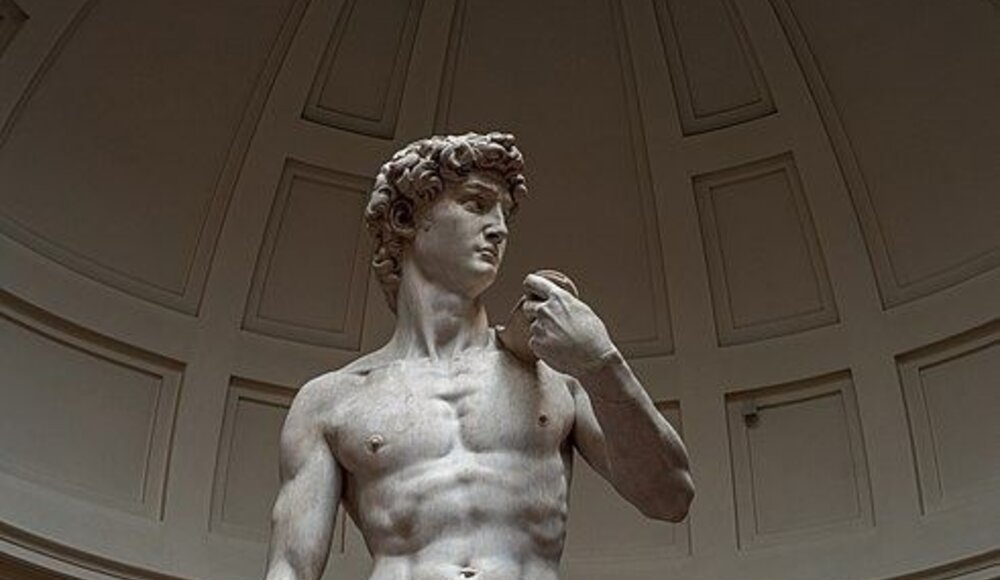
 Olimpia Gaia Martinelli
Olimpia Gaia Martinelli
